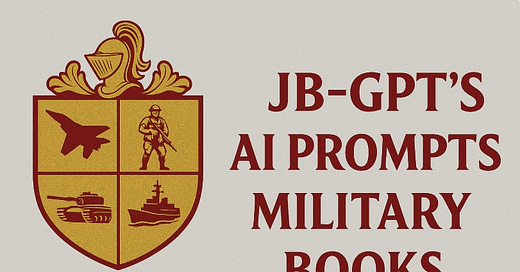2025-099 JB-GPT's AI PROMPT: BOOKS... Air Power Supplement Published 2022 – 2025
A collection of useful books to improve understanding of the application of Air Power during War.
LINK TO: JB-GPT’s AI PROMPTS MILITARY HISTORY WEB PAGE.
COMMENTS/CONTACT: zzzz707@live.com.au
This structured AI prompt may be used to develop additional AI-generated answers to follow up questions.
***Disagree with the AI? Say so—challenge it. These prompts are a starting point, not the final word.***
VIP...When answering questions this AI — must ONLY use references from the following sources:
https://www.jb-gpt-prompts.com/jb-gpts-military-references
https://www.jb-gpt-prompts.com/AP-BIBLIOGRAPHY
https://www.jb-gpt-prompts.com/jb-gpts-sea-power-bibliography
Bibliography or endnotes included with this prompt.
**********************************************************
‘SELECT ALL’ and cut and paste everything into the input box of the AI of your choice.
Once you have pasted everything into another AI, write in your question(s).
Q1 ……..
**********************************************************2025-099 JB-GPT's AI PROMPT: BOOKS... 'Air Power' 'Airpower' Published 2022 – 2025
1. Air Power at Sea, 1939–45 – John Winton
Overview: This book explores the role of air power in naval warfare during World War II, detailing how aircraft transformed battles at sea and rendered ships vulnerable both in open waters and harbors. It covers key naval-air battles, including Taranto, Midway, and Okinawa.
Key Point: Aircraft carriers became decisive strategic assets, shifting naval combat from ship-to-ship engagements to air-dominated conflicts. Reference: Winton, Air Power at Sea, 1939–45, Ch. 1.
2. Allies in Air Power: A History of Multinational Air Operations – Steven Paget
Overview: This book analyzes multinational air operations, from World War I to modern coalition efforts, highlighting both strategic advantages and coordination challenges.
Key Point: Multinational air operations require careful integration of doctrine, training, and logistics to ensure efficiency. Reference: Paget, Allies in Air Power, Ch. 10.
3. Air Power and the Evacuation of Dunkirk – Harry Raffal
Overview: The book reassesses the role of the Royal Air Force in Operation Dynamo, countering claims that air support was insufficient and emphasizing the unseen battles fought inland.
Key Point: Fighter Command’s success in preventing Luftwaffe dominance over Dunkirk was crucial to the evacuation’s success. Reference: Raffal, Air Power and the Evacuation of Dunkirk, Ch. 1.
4. Air Power in the Falklands Conflict – John Shields
Overview: This book examines the role of air power in the 1982 Falklands War, analyzing both British and Argentine air operations.
Key Point: Air power was critical in shaping the Falklands campaign, particularly in logistics, reconnaissance, and air superiority. Reference: Shields, Air Power in the Falklands Conflict, Ch. 1.
5. Educating Air Forces – Randall Wakelam, David Varey, Emanuele Sica
Overview: A comparative study of air power education across various nations, assessing how air forces train officers for strategic leadership.
Key Point: Professional military education is essential in shaping air force leadership and adapting to technological advancements. Reference: Wakelam et al., Educating Air Forces, Ch. 3.
6. Military Strategy, Joint Operations, and Airpower – Ryan Burke, Michael Fowler, Jahara Matisek
Overview: This book introduces key concepts in modern military strategy, focusing on the integration of air power within joint operations across different levels of warfare.
Key Point: Air power must be employed strategically within joint operations to maximize effectiveness in modern conflicts. Reference: Burke et al., Military Strategy, Joint Operations, and Airpower, Ch. 1.
7. Military Air Power in Europe: Preparing for War – Norman Ridley
Overview: Examines the development of European air forces leading up to World War II, focusing on their doctrines, capabilities, and strategic planning.
Key Point: European air forces developed distinct doctrines based on national military objectives, with Germany leveraging early experiences in the Spanish Civil War. Reference: Ridley, Military Air Power in Europe: Preparing for War, Ch. 3.
8. Bloody April 1917 – James Corum
Overview: This book analyzes the air battles over the Western Front in April 1917, highlighting the evolution of aerial tactics and the significance of air superiority.
Key Point: The development of coordinated aerial reconnaissance and artillery spotting marked a major shift in air power strategy during World War I. Reference: Corum, Bloody April 1917, Ch. 5.
9. Rain of Ruin: Tokyo, Hiroshima, and the Surrender of Japan – Richard Overy
Overview: Examines the strategic bombing campaign against Japan, including the firebombing of Tokyo and the atomic bombings of Hiroshima and Nagasaki.
Key Point: The combined effects of firebombing and atomic strikes significantly contributed to Japan’s surrender by August 1945. Reference: Overy, Rain of Ruin, Ch. 4.
10. Sustaining the Carrier War – Stan Fisher
Overview: This book explores how the U.S. Navy maintained its carrier-based air power in the Pacific during World War II, focusing on logistics, maintenance, and operational sustainability.
Key Point: The success of carrier operations in the Pacific relied heavily on robust logistics, trained personnel, and continuous aircraft resupply. Reference: Fisher, Sustaining the Carrier War, Ch. 6.



